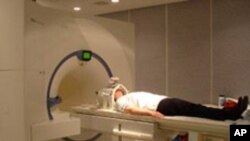Researchers are experimenting with high-tech brain imaging to determine which patients with clinical depression are more likely to be helped by medication and who could benefit most from counseling. They have identified one area of the brain that “lights up” in response to either talk therapy or medications.
According to some estimates, antidepressants are highly effective in treating 80 to 90 percent of patients. Other studies suggest the medications are not much better than sugar pills in easing symptoms of clinical depression.
Helen Mayberg, a researcher at Emory University in Atlanta, Georgia, notes the first treatment for depression often fails.
“The problem is that whatever you get, the published numbers, even in randomized studies, is getting people well - the remission rate is about 40 percent, which means, for most people, the first thing you are given is not likely to work," said Mayberg.
The result is that most doctors are left treating patients on a trial and error basis until they find something that works.
Now, Emory researchers, led by Mayberg, are using high-tech brain imaging, called PET, to try to identify which patients are likely to benefit from medication and who would be most helped by a form of talk therapy called cognitive behavior therapy.
PET, which stands for positron emission tomography, uses a radioactive sugar molecule that traces the brain circuitry, lighting up areas that become activated by stimuli. Researchers identified the anterior insula, one particular region in a group of 63 depressed patients, that seemed to be predictive.
Patients with a sluggish insula at the start of the study did best with cognitive therapy, while those with overactive insulas had better relief from the study medication, Lexapro.
Mayberg says the insula is part of a system in the brain associated with monitoring the internal state of the body, and becomes activated during times of extreme distress.
The insula’s role as a possible biomarker for depression needs to be replicated, according to Mayberg, who says her findings could help put treatment of psychiatric disorders on an equal footing with other medical conditions.
“…where we do tests of various sorts to make management decisions all the time. Whereas in breast cancer, we do tumor markers in order to determine both that a treatment is likely to help you but also determine without a marker that certain treatments are not for you," she said.
An article on using high-tech brain imaging in the treatment of clinical depression was published recently in the journal JAMA Psychiatry.
According to some estimates, antidepressants are highly effective in treating 80 to 90 percent of patients. Other studies suggest the medications are not much better than sugar pills in easing symptoms of clinical depression.
Helen Mayberg, a researcher at Emory University in Atlanta, Georgia, notes the first treatment for depression often fails.
“The problem is that whatever you get, the published numbers, even in randomized studies, is getting people well - the remission rate is about 40 percent, which means, for most people, the first thing you are given is not likely to work," said Mayberg.
The result is that most doctors are left treating patients on a trial and error basis until they find something that works.
Now, Emory researchers, led by Mayberg, are using high-tech brain imaging, called PET, to try to identify which patients are likely to benefit from medication and who would be most helped by a form of talk therapy called cognitive behavior therapy.
PET, which stands for positron emission tomography, uses a radioactive sugar molecule that traces the brain circuitry, lighting up areas that become activated by stimuli. Researchers identified the anterior insula, one particular region in a group of 63 depressed patients, that seemed to be predictive.
Patients with a sluggish insula at the start of the study did best with cognitive therapy, while those with overactive insulas had better relief from the study medication, Lexapro.
Mayberg says the insula is part of a system in the brain associated with monitoring the internal state of the body, and becomes activated during times of extreme distress.
The insula’s role as a possible biomarker for depression needs to be replicated, according to Mayberg, who says her findings could help put treatment of psychiatric disorders on an equal footing with other medical conditions.
“…where we do tests of various sorts to make management decisions all the time. Whereas in breast cancer, we do tumor markers in order to determine both that a treatment is likely to help you but also determine without a marker that certain treatments are not for you," she said.
An article on using high-tech brain imaging in the treatment of clinical depression was published recently in the journal JAMA Psychiatry.







